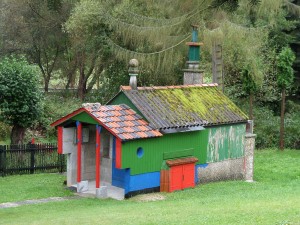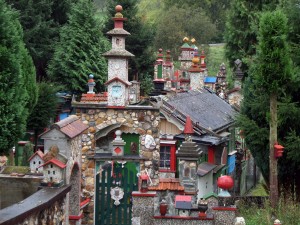The Fischbach Folly
Monday, October 13th, 2014I’d love to post these photographs on Folly Fancier, but as Facebook strips all metadata as a matter of course so that images become orphan works, I refuse to do so on professional grounds.
Diatribe over. This is astounding: a serendipitous discovery just off a German road in the Taunus hills on which I’d travelled annually for the past 12 years, until someone’s bad luck created my good luck. The bad luck was a lorry in trouble on the main road, a two-lane black top on which I’d normally be doing 60mph. As I sat in the stationary queue behind the stricken truck and glanced through the trees on my left, I saw a golden cube seemingly suspended in the air. There was a glimpse of a red arch. I did a quick U-turn and hared back down the road to find a turn-off. Within minutes I was at the site.
This is a stupendous, huge, scrap shack, a term I used in “Architectural Follies in America” to describe a particular type of agglomerative folly using found materials. The supreme example is of course the Palais Idéal of the Facteur Cheval in Hautrive, France, but there are epigons all over the world — the Owl Garden in Nieuw Bethesda, South Africa; Arthur Vanabelle‘s ordnance array in Steenwerck on the Belgian border; Captain Nitwit’s nine-storey shack in Cambria, California; all unconnected and unaware of each other — and now this amazing collection of structures in Fischbach in Taunus.
Let me say straight away that I’ve rushed into print before I know anything about the building, what it’s actually called or even who built it. All I know is that he has the initials GH (writes Gwyn Headley). Why? Because they’re painted in red on the gate. Why he? Because they always are. This isn’t woman’s work.
Like all random, patternless work, this follows the usual pattern. Our GH probably started with a shed, which he painted, then he added a buttress, or a steeple, or an arch until his passion overwhelmed him and he burst into this florid exultation of pure construction we can rejoice in today. He may still be alive — Fischbach Folly appears to be in good condition — but on my rainy day of discovery the gate was firmly shut. It is not in any sense ruinous or derelict. I cannot find any trace of it on the web. The Fischbach official website has no mention of it, so they don’t regard it as a tourist attraction. It doesn’t help that Germans have no concept of follies, despite Neuschwanstein.
So I have to leave you (and me) hanging, and let the photographs, taken on a damp, drizzly, dark grey day, speak for themselves. And this serves as a plea — is there anyone who can tell us more about this wonderful edifice? I have my spies on the ground in Germany, but they are not folly people.





